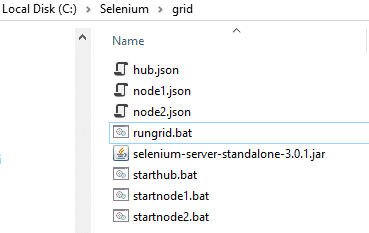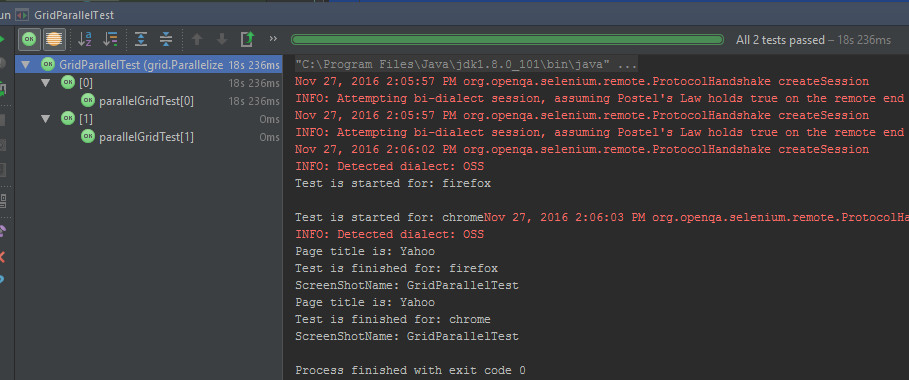In this post, I will give two techniques and describe how to run your selenium parallel tests by using Selenium Grid (SG) and JUnit.
Prerequisites
Nice to have: Before starting to read this post it is better to read previous selenium tutorials.
First, if you do not know how to use SG, please check this article. In this article, we created hub.json, node.json, starthub.bat and startnode.bat files. Now, let’s modify them for parallel test execution.
Selenium Grid Setup for Parallel Test Execution
Our setup will be like that; we will have two nodes and one hub. Each node has got 5 Chrome, 5 Firefox and 1 Internet Explorer browser instances. The first node will use port 5555 and the second one will use 5556. Thus, we will create two node JSON files. These are node1.json and node2.json. The only difference between these JSON files is port number.
{
"capabilities":
{
"browserName": "firefox",
"maxInstances": 5,
"seleniumProtocol": "WebDriver"
},
{
"browserName": "chrome",
"maxInstances": 5,
"seleniumProtocol": "WebDriver"
},
{
"browserName": "internet explorer",
"maxInstances": 1,
"seleniumProtocol": "WebDriver"
}
],
"proxy": "org.openqa.grid.selenium.proxy.DefaultRemoteProxy",
"maxSession": 5,
"port": 5555,
"register": true,
"registerCycle": 5000,
"hub": "http://localhost:4444",
"nodeStatusCheckTimeout": 5000,
"nodePolling": 5000,
"role": "node",
"unregisterIfStillDownAfter": 60000,
"downPollingLimit": 2,
"debug": false,
"servlets" : [],
"withoutServlets": [],
"custom": {}
}
{
"capabilities":
[
{
"browserName": "firefox",
"maxInstances": 5,
"seleniumProtocol": "WebDriver"
},
{
"browserName": "chrome",
"maxInstances": 5,
"seleniumProtocol": "WebDriver"
},
{
"browserName": "internet explorer",
"maxInstances": 1,
"seleniumProtocol": "WebDriver"
}
],
"proxy": "org.openqa.grid.selenium.proxy.DefaultRemoteProxy",
"maxSession": 5,
"port": 5556,
"register": true,
"registerCycle": 5000,
"hub": "http://localhost:4444",
"nodeStatusCheckTimeout": 5000,
"nodePolling": 5000,
"role": "node",
"unregisterIfStillDownAfter": 60000,
"downPollingLimit": 2,
"debug": false,
"servlets" : [],
"withoutServlets": [],
"custom": {}
}
We created two node JSON files. Our hub.JSON file remains same as shown below.
{
"port": 4444,
"newSessionWaitTimeout": -1,
"servlets" : [],
"withoutServlets": [],
"custom": {},
"capabilityMatcher": "org.openqa.grid.internal.utils.DefaultCapabilityMatcher",
"throwOnCapabilityNotPresent": true,
"cleanUpCycle": 5000,
"role": "hub",
"debug": false,
"browserTimeout": 0,
"timeout": 1800
}
In order to start Selenium Grid (hub and nodes), we should write .bat files. These are; startnode1.bat, startnode2.bat, starthub.bat and to trigger all of these .bat files with a single .bat file I will create a rungrid.bat file. All these .bat files are shown below.
java -jar selenium-server-standalone-3.0.1.jar -role hub -hubConfig hub.json
java -jar -Dwebdriver.gecko.driver=C:\Selenium\drivers\firefox\geckodriver.exe -Dwebdriver.chrome.driver=C:\Selenium\drivers\chrome\chromedriver.exe selenium-server-standalone-3.0.1.jar -role node -nodeConfig node1.json
java -jar -Dwebdriver.gecko.driver=C:\Selenium\drivers\firefox\geckodriver.exe -Dwebdriver.chrome.driver=C:\Selenium\drivers\chrome\chromedriver.exe selenium-server-standalone-3.0.1.jar -role node -nodeConfig node2.json
start starthub.bat start startnode1.bat start startnode2.bat
After these settings our C:\Selenium\Grid folder will look like below.

When we run “rungrid.bat” file it starts hub a nd nodes consecutively. After that, when you go to http://localhost:4444/grid/console you will see that two nodes registered to one hub as shown below.
Now, we are ready to code parallel test execution with our grid setup. I will show you two techniques to run your selenium tests with JUnit.
JUnit Parallel Test Execution Techniques
1) Run Selenium Tests in Parallel using JUnit’s Parallel Computer Class
ParallelComputer documentation is here: http://junit.org/junit4/javadoc/4.12/org/junit/experimental/ParallelComputer.html
By using below logic you can run your JUnit cases in parallel.
@Test
public void runAllTests() {
Class<?>[] classes = {ParallelTest1.class,ParallelTest2.class};
// ParallelComputer(true,true) will run all classes and methods
// in parallel. (First arg for classes, second arg for methods)
// I set true, true this means classes and methods runs in parallel.
JUnitCore.runClasses(new ParallelComputer(true, true), classes);
}
In above method first parameter of ParallelComputer() is for classes and the second one is for methods. Here, I will run classes and methods in parallel. Because I set both parameters as true.
Now, Let’s prepare a test scenario and then write its code.
Test Scenario:
- In first test Class;
- Open Facebook with Chrome in first test method
- Open Amazon with Firefox in second test method
- In second test Class;
- Open Yahoo with Chrome.
We have two test classes. In first test class, we have two test methods and in the second one, we have one test method.
Test Code:
I used 4 classes for this test. First one is DriverManager, it sets which browser driver will be used for the test. GridParallelComputerTest class modifies ParallelComputer class and runs the tests in parallel, the other two classes are test classes, ParallelTest1 and ParallelTest2.
import org.openqa.selenium.Platform;
import org.openqa.selenium.WebDriver;
import org.openqa.selenium.remote.DesiredCapabilities;
import org.openqa.selenium.remote.RemoteWebDriver;
import java.net.MalformedURLException;
import java.net.URL;
/**
* Created by ONUR on 24.11.2016.
*/
//Driver Manager Class
public class DriverManager {
public WebDriver driver;
public WebDriver getDriver(String browser) throws MalformedURLException {
//Set Browser Type
DesiredCapabilities caps = null;
if (browser == "chrome") {
caps = DesiredCapabilities.chrome();
} else if (browser == "firefox") {
caps = DesiredCapabilities.firefox();
}
caps.setPlatform(Platform.WINDOWS);
return driver = new RemoteWebDriver(new URL("http://localhost:4444/wd/hub"), caps);
}
}
import org.junit.After;
import org.junit.Before;
import org.junit.Test;
import org.junit.experimental.ParallelComputer;
import org.junit.runner.JUnitCore;
import org.openqa.selenium.By;
import org.openqa.selenium.Platform;
import org.openqa.selenium.WebDriver;
import org.openqa.selenium.WebElement;
import org.openqa.selenium.remote.DesiredCapabilities;
import org.openqa.selenium.remote.RemoteWebDriver;
import java.net.MalformedURLException;
import java.net.URL;
/**
* Created by ONUR on 20.11.2016.
*/
public class GridParallelComputerTest {
/* ~~~~~~Description~~~~~~
Run All Test in Parallel with JUnit's ParallelComputer feature.
By using below logic you can run your junit cases in parallel.
Class[] cls={test1.class,test2.class,test3.class,test4.class};
JUnitCore.runClasses(new ParallelComputer(true,true),cls);
In above method first parameter of ParallelComputer() indicates classes and second one is for methods.
Here I'm running classes and methods in parallel.
ParallelComputer Class documentation is below:
http://junit-team.github.io/junit/javadoc/4.10/org/junit/experimental/ParallelComputer.html
*/
@Test
public void runAllTests() {
Class<?>[] classes = {ParallelTest1.class,ParallelTest2.class};
// ParallelComputer(true,true) will run all classes and methods
// in parallel. (First arg for classes, second arg for methods)
// I set true, true this means classes and methods runs in parallel.
JUnitCore.runClasses(new ParallelComputer(true, true), classes);
}
}
import org.junit.After;
import org.junit.Test;
import java.net.MalformedURLException;
/**
* Created by ONUR on 24.11.2016.
*/
public class ParallelTest1 extends DriverManager {
//Chrome Test
@Test
public void testChrome1() throws MalformedURLException {
driver = new DriverManager().getDriver("chrome");
driver.navigate().to("http://www.facebook.com/");
driver.manage().window().maximize();
}
//Firefox Test
@Test
public void testFirefox1() throws MalformedURLException {
driver = new DriverManager().getDriver("firefox");
driver.navigate().to("http://www.amazon.com/");
driver.manage().window().maximize();
}
@After
public void quitDriver() {
driver.quit();
}
}
import org.junit.After;
import org.junit.Test;
import java.net.MalformedURLException;
/**
* Created by ONUR on 24.11.2016.
*/
//Second Test Class
public class ParallelTest2 extends DriverManager {
//Chrome Test
@Test
public void testChrome2() throws MalformedURLException {
driver = new DriverManager().getDriver("chrome");
driver.navigate().to("http://www.yahoo.com/");
driver.manage().window().maximize();
}
@After
public void quitDriver() {
driver.quit();
}
}
2) Run Selenium Tests in Parallel using JUnit’s Parametrized Class
Parallellized class is a helper class and you can define threat count in this class’s ThreadPoolScheduler method. In GridParallelTestBase class, I set which browsers I will use for the test by using @Parameterized.Parameters annotation. Here, I added Chrome and Firefox browsers. Thus, our test will open two browsers and they will be Chrome and Firefox.
I created DesiredCapabilities and RemoteWebdriver below @Before annotation. All test setup is done in this Class’s setup method and I also added a screenshot capture method in this class.
GridParallelTest class is our test class and it extends GridParallelTestBase class. In its test method, I set the platform, go to yahoo.com, print the yahoo’s title, and take a screenshot.
import org.junit.runners.Parameterized;
import org.junit.runners.model.RunnerScheduler;
import java.util.concurrent.ExecutorService;
import java.util.concurrent.Executors;
import java.util.concurrent.TimeUnit;
public class Parallelized extends Parameterized {
private static class ThreadPoolScheduler implements RunnerScheduler {
private ExecutorService executor;
//You can set number of parallel threads in this method.
//I set 5 and our grid will run 5 parallel test execution.
public ThreadPoolScheduler() {
String threads = System.getProperty("junit.parallel.threads", "5");
int numThreads = Integer.parseInt(threads);
executor = Executors.newFixedThreadPool(numThreads);
}
//@Override
public void finished() {
executor.shutdown();
try {
executor.awaitTermination(10, TimeUnit.MINUTES);
} catch (InterruptedException exc) {
throw new RuntimeException(exc);
}
}
//@Override
public void schedule(Runnable childStatement) {
executor.submit(childStatement);
}
}
public Parallelized(Class<?> klass) throws Throwable {
super(klass);
setScheduler(new ThreadPoolScheduler());
}
}
import org.apache.commons.io.FileUtils;
import org.junit.Before;
import org.junit.runners.Parameterized;
import org.openqa.selenium.*;
import org.openqa.selenium.firefox.FirefoxDriver;
import org.openqa.selenium.firefox.FirefoxProfile;
import org.openqa.selenium.remote.Augmenter;
import org.openqa.selenium.remote.CapabilityType;
import org.openqa.selenium.remote.DesiredCapabilities;
import org.openqa.selenium.remote.RemoteWebDriver;
import java.io.File;
import java.io.IOException;
import java.net.URL;
import java.util.LinkedList;
/**
* Created by onurb on 26-Nov-16.
*/
public class GridParallelTestBase {
//Declare DesiredCapabilities configuration variables
protected String browserName;
protected Platform platformName;
protected WebDriver driver;
//Hold all Configuration values in a LinkedList
//Extra Usage Information: http://www.swtestacademy.com/junit-parametrized-tests/
@Parameterized.Parameters
public static LinkedList<String[]> getEnvironments() throws Exception {
LinkedList<String[]> env = new LinkedList<String[]>();
env.add(new String[]{"firefox"});
env.add(new String[]{"chrome"});
//add more browsers here
return env;
}
//Constructor
public GridParallelTestBase(String browserName) {
this.browserName = browserName;
}
public void setPlatform (Platform platform) {
platformName = platform;
}
@Before
public void setUp() throws Exception {
//Set DesiredCapabilities
DesiredCapabilities capabilities = new DesiredCapabilities();
//Firefox Profile Settings
if (browserName.equals("firefox")) {
FirefoxProfile profile = new FirefoxProfile();
//Accept Untrusted Certificates
profile.setAcceptUntrustedCertificates(true);
profile.setAssumeUntrustedCertificateIssuer(false);
//Use No Proxy Settings
profile.setPreference("network.proxy.type", 0);
//Set Firefox profile to capabilities
capabilities.setCapability(FirefoxDriver.PROFILE, profile);
}
//Set Platform
capabilities.setPlatform(platformName);
//Set BrowserName
capabilities.setCapability("browserName", browserName);
capabilities.setCapability("build", "JUnit-Parallel");
driver = new RemoteWebDriver(new URL("http://localhost:4444/wd/hub"), capabilities);
}
//TakeScreenShot
public void takeScreenShot () {
driver = new Augmenter().augment(driver);
File srcFile = ((TakesScreenshot) driver).getScreenshotAs(OutputType.FILE);
String screenshotName = getClass().getSimpleName();
System.out.println("ScreenShotName: " + screenshotName);
try {
FileUtils.copyFile(srcFile, new File("screenshotName.png"));
} catch (IOException e) {
e.printStackTrace();
}
}
}
import org.junit.After;
import org.junit.Test;
import org.junit.runner.RunWith;
import org.openqa.selenium.Platform;
@RunWith(Parallelized.class)
public class GridParallelTest extends GridParallelTestBase{
//Constructor
public GridParallelTest(String browserName) {
super(browserName);
}
@Test
public void parallelGridTest() throws Exception {
//Set Platform Name
setPlatform(Platform.WIN10);
//Go to Amazon.com
System.out.println("Test is started for: "+ browserName);
driver.get("http://www.yahoo.com");
System.out.println("Page title is: " + driver.getTitle());
System.out.println("Test is finished for: "+ browserName);
//ScreenShot Section
takeScreenShot();
}
@After
public void tearDown() throws Exception {
driver.quit();
}
}
After run this test you will see that two browsers (Chrome & Firefox) will open in parallel and tests will be passed.

See you in another article ;)
Github Link: https://github.com/swtestacademy/GridTests
Selenium Webdriver Tutorial Series
[fusion_widget_area name=”avada-custom-sidebar-seleniumwidget” title_size=”” title_color=”” background_color=”” padding_top=”” padding_right=”” padding_bottom=”” padding_left=”” hide_on_mobile=”small-visibility,medium-visibility,large-visibility” class=”” id=””][/fusion_widget_area]
-Onur

Onur Baskirt is a Software Engineering Leader with international experience in world-class companies. Now, he is a Software Engineering Lead at Emirates Airlines in Dubai.



like it ! nice job bro !
Thanks mate! ;)
Thanks. Nice tutorial
Thank you! :)
Hi
I was trying with these 2 ways to run test parallel, but I’m always getting connection refused error.
Any idea for this?
Thank you.
Hi @Joel,
Maybe below links help you for this problem.
http://stackoverflow.com/questions/40019066/webdrivererror-connection-refused
https://sqa.stackexchange.com/questions/5833/connection-refused-error-when-running-selenium-with-chrome-and-firefox-drivers
https://github.com/seleniumhq/selenium-google-code-issue-archive/issues/2191
Is there a way to change the number of instances to 20?
https://stackoverflow.com/questions/13723349/selenium-grid-maxsessions-vs-maxinstances please check this link. If you want to use 20 instances in parallel, it is better to do it with docker-selenium on Linux. I will write an article about this in next days. On windows, it will be a little bit slower.
Nice blog posts.
Maybe a bit of topic, but do you know if this would also be possible with Ruby?
I’m using Ruby with a gem called lapis_lazuli (https://github.com/spriteCloud/lapis-lazuli) which I find really easy to use.
Thank you Mark. You can ask this Alper Mermer via linkedin.com. He is doing test automation with Ruby. He has more knowledge on this topic. I am good at JAVA & TestNG & JUNIT. :) I did a google search and found this link. https://stackoverflow.com/questions/7565844/running-parallel-selenium-tests-with-capybara
If you ship more than one browser, only one manoeuvre will work.
There are 20 test methods and the following errors occur when you build them :
1. Element not visible
2. ElementNotInteractableException
Please use the this tutorial to assist me.
Unparalleled. Thanks!
Very helpful info. on selenium grid setup with JSON config, could you please provide any link on how to run in CI with testng.xml
Thanks. We will write an article on that topic soon.
Hi, i’m trying to run two chrome tests in parallel, but their seems to be an issue only one test runs on browser, the other browser stays blank. any suggestions appreciated
<class name="test1"
<class name="test2"
Onur, i am getting org.openqa.selenium.StaleElementReferenceException: Element not found in the cache – perhaps the page has changed since it was looked up, when i am trying to execute two methods in parallel present in one class.
I did not get it but StaleElement exceptions generally caused by when an element does not exist in the DOM. Maybe, it is a synchronization problem.
I really loved it. It’s clean and clear. Thanks a lot for sharing it.
You are welcome Shamim. :)